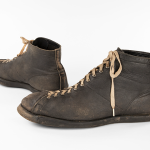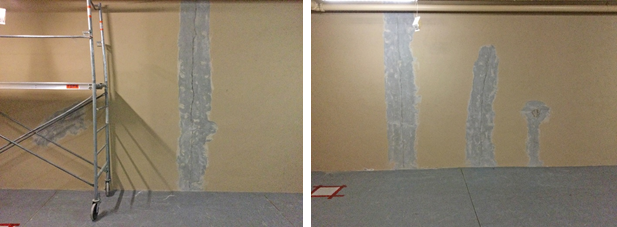There are two mannequin forms that were created for a pair of Inuit pants and a pair of Greenlandic shorts both on display in Art and Innovation: Traditional Arctic Footwear from the Bata Shoe Museum Collection. The exhibition designer determined that the best look would be to pass an acrylic rod through each leg. An element of the fabrication of the mannequin in Part I was adapted for these items of clothing.
The interior of the legs of the sealskin pants are supported with large cones created from acid free card stock; its seams adhered with hot melt glue. Four extra-long lengths of 1” wide cotton twill tape were hot melt glued to the sides of each leg cone. These ties would be employed later in the process. A disc of ethafoam covered with a grey poly cotton stretch knit was inserted into the card stock cone at the base of each leg. A hole was bored through the centre of each disc. The discs were then secured in place with hot melt glue.
Two ethafoam discs, also with centre holes, were cut to fill the top of each leg cone. A panel of coroplast was cut to cover the top of both leg cones combined. A slit was cut in the centre of the coroplast panel using an exacto knife. These discs were hot melt glued to the underside of the plastic panel. An awl was used to make holes on either side of the corplast & through the foam discs. Screws with washers and nuts were threaded through each side and the twill tape ends at the top of the inside of each leg were passed through the slit to the top of the coroplast.
The tape attached to the leg exteriors & the central tapes were pulled tightly to fit the coroplast/foam panel to the top of the leg cones. The upper foam discs were hot melt glued to the top of the leg cones. The twill tape was hot melt glued to the top of the coroplast and excess was cut away. The space between the coroplast and the pants in the bum area was fill with tissue paper and foam. Then the coroplast panel and filler were covered with the same stretch knit as the base of the legs. An acrylic rod with base attached was threaded through the holes in the foam at the base of each leg and lodged into the hole of the foam discs at the top of each leg.





